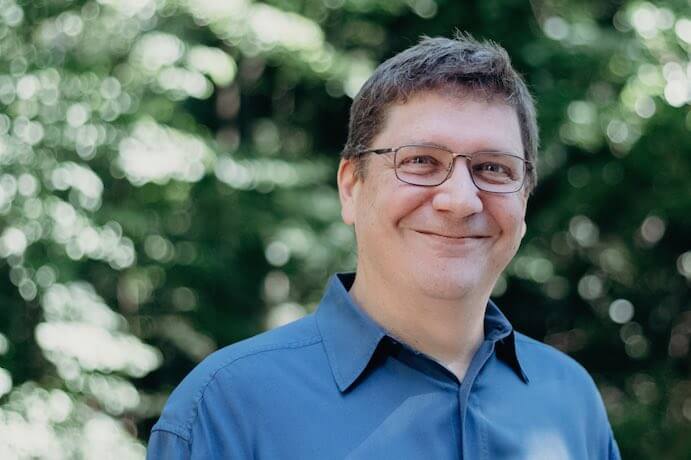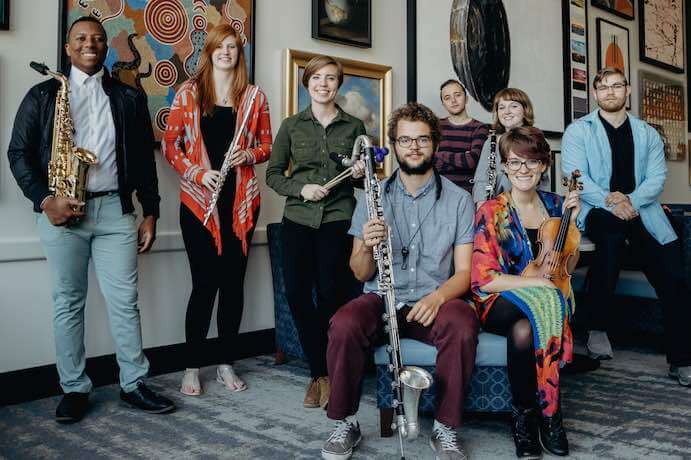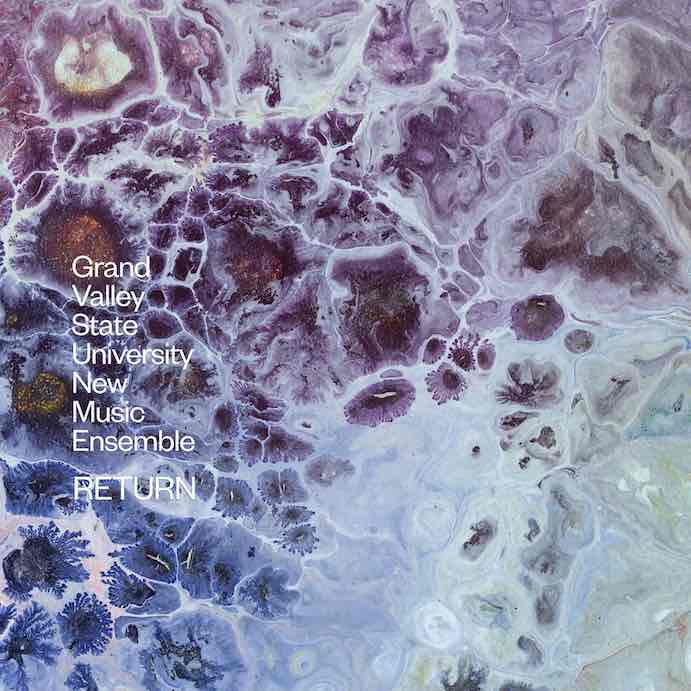The Grand Valley State University New Music Ensemble’s (GVSUNME) newest album, RETURN, features the music of composers Daniel Rhode, Adam Cuthbért, and Matt Finch. All three are alumni of GVSU and members of slashsound, “a record label and artist collective that weaves the everyday landscape of urban living with digital audio/visual production.” The ensemble, directed by GVSU faculty-member Bill Ryan, has produced 4 albums since its inception in 2006, and RETURN is the third of those albums released by Innova records.
Those familiar with GVSUNME know the group as an instrumental ensemble that tackles difficult modern repertoire with finesse. However, this genre-shattering album breaks the mold of expectations that surround a collegiate new music ensemble. Those expecting an album of freshly composed acoustic pieces will find that the GVSUNME has taken us to another planet altogether, where the compositional process is as fascinating as the end result. This music was created in a multi-stage process, where the ensemble recorded acoustic music written by Rhode, Cuthbért, and Finch. The GVSUNME performers did an admirable job in providing the composers with stellar recordings of the acoustic works. The composers then used these recordings to create new works through liberal usage of computer processing. The resultant tracks turn acoustic instruments into found sound objects, organized through kaleidoscopes that create alien soundscapes while evoking familiar images.

GVSUNME Director Bill Ryan
A work as peaceful as it’s title suggests, Daniel Rhode’s glass surface, earned the accolade of NPR’s 100 Best Songs of 2017. It evokes the sense of stillness and stasis, through which the image of a distant bagpipe emerges (processed violin) placing the listener at the banks of a foggy Scottish lake. Matthew Finch’s glacier presents the listener with shrill and icy high frequencies that find themselves in a slowly warming environment as the prominence of the mid- and low-range sounds materialize at a glacial pace into the texture and droplets of water melt-off in Morse code-like rhythms. As a listener, I found myself heavily contemplating the politics surrounding the climate change debate, an ironic situation where all the voices shouting seem to be louder than the quiet cries for help of our planet, becoming unheard and ignored. A similar sound image is evoked in Finch’s with a hint of blue, a work that begins with an ostinato set in an ice-cold cavern where echoes of a processed piano bounce off a watery surface while the whimpering of processed woodwinds can be heard in the distance, muted by a thick wall of ice.

Grand Valley State University New Music Ensemble–Photo by Bill Ryan
Heavily influenced by minimalism and post-minimalism alike, this album has tracks with overt references to the generation prior; the miniature ash (Rhode) references the rhythmic motives familiar to Steve Reich’s Vermont Counterpoint, while the overlapping polyrhythms in Cuthbért’s background refresh nods to Reich’s earlier experiments with tape phasing, mixed with an Electronic Dance Music flair. In another Reich-influenced work, Rhode’s dearest rewinder these established a mixed meter groove, to which an electric guitar-like riff is added (possibly processed violin) that quickly gets out of phase with an added flute motive. Other instruments join and quickly thicken the texture, evoking the same trance listening experience of the post-minimal masters. A large-scale accelerando provides the musical form for Cuthbért’s there are no gradients, where the frequency of each sound-object increases throughout the six-and-a-half minute composition. Vestiges of tonality emerge in the pentatonic soundscape of return (Rhode), while a full-scale spectralist assault is launched in the processed spectra of the baritone sax and flute sounds in location sharing (Cuthbért).
This 15-track album presents 15 unique soundscapes, transferring us to a wide berth of sonic experiences. While the music is largely atmospheric, it rejects the boring nature that often associates within the subgenre. If you are a fan of electro-acoustic music, take note of these three young composers, and add the Grand Valley State University New Music Ensemble to you list of groups to pay attention to; their musical excursions continue to impress.




















